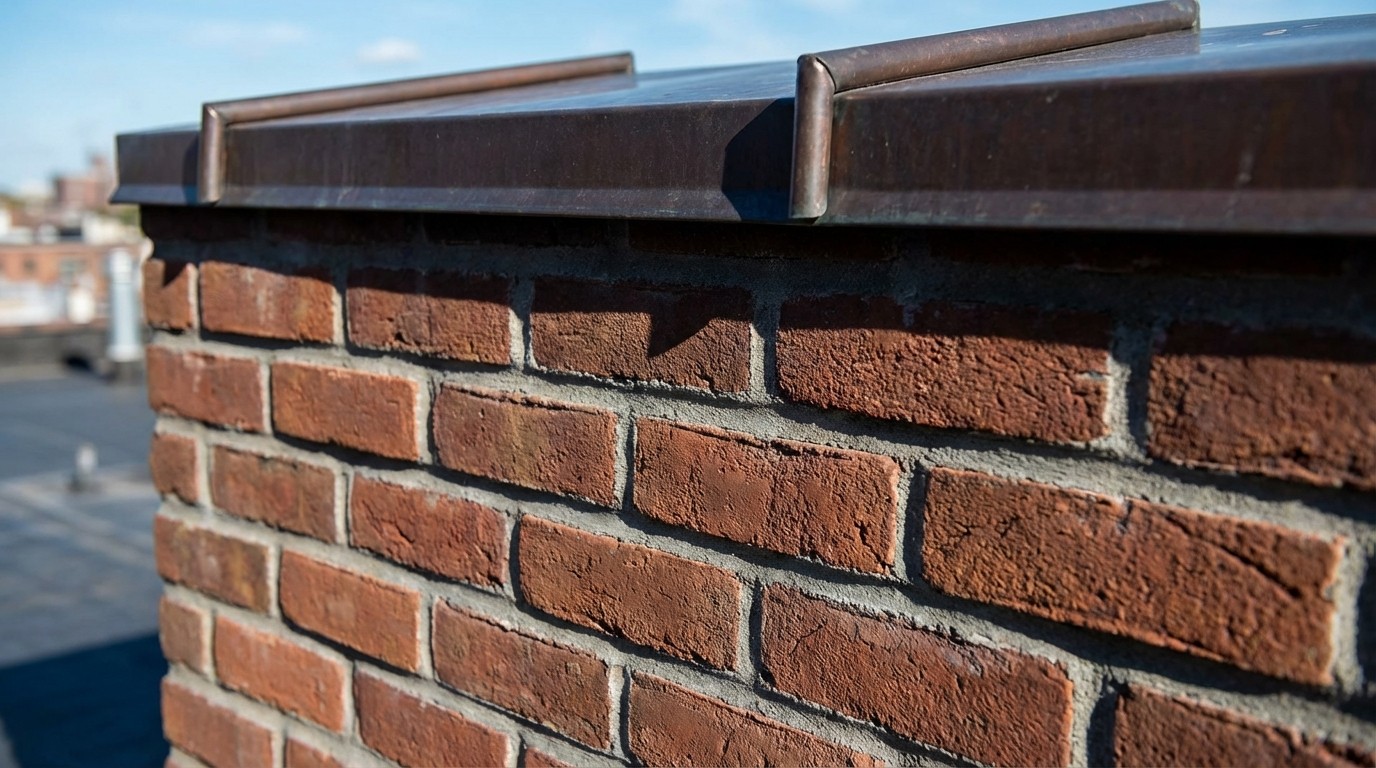Metal roofing comes in more varieties than most homeowners realize, and understanding these differences can help you make the best choice for your wallet and your home's long-term protection
This guide breaks down the main metal roofing materials, from budget-friendly steel to premium copper, along with the panel styles available for each. You'll also find real cost comparisons and the key factors that make quotes vary so widely from one contractor to the next.
Types of metal roofing materials
Metal roofing is categorized two ways: by material and by panel style. The material, whether steel, aluminum, copper, or zinc, determines how long your roof lasts, how it handles weather, and what it costs. The panel style, like standing seam or corrugated, affects how your roof looks and how contractors install it.
Most homeowners choose steel or aluminum since copper and zinc can cost 3-5 times more than steel options...
Let's walk through each material first, then cover the panel styles.
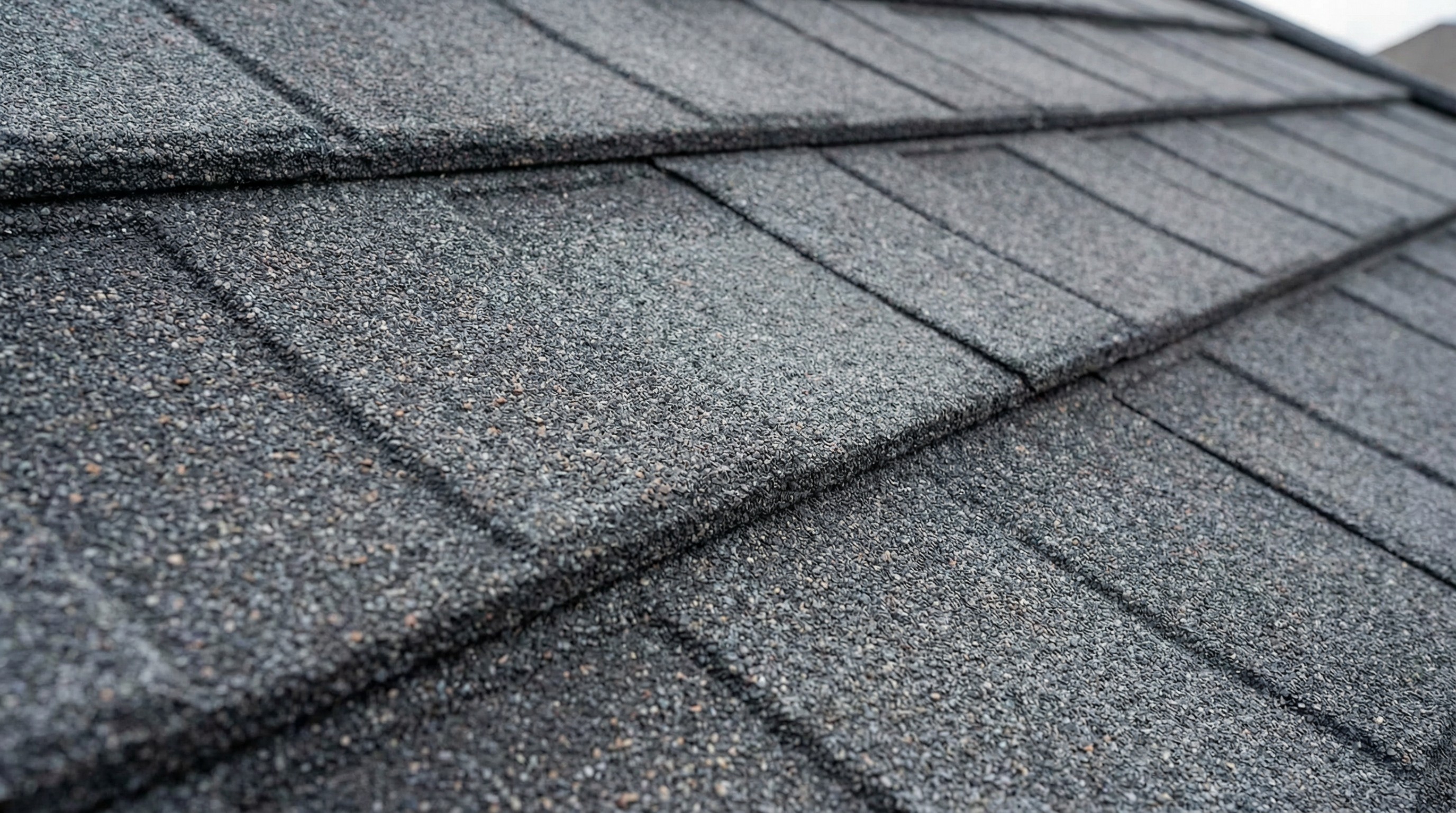
Steel roof types for homes
Steel is the most common metal roofing material for homes, and it comes in several variations based on how manufacturers coat it to prevent rust. The coating matters because bare steel would corrode quickly when exposed to rain and humidity.
Galvanized steel roofing
Galvanized steel has a zinc coating applied to the surface. The zinc acts as a protective layer that keeps water away from the steel underneath, preventing rust for many years. It's affordable and works well in most climates, though the zinc layer can wear down over decades, especially in areas with harsh weather or high humidity.
Galvalume steel roofing
Galvalume steel uses a coating that combines aluminum and zinc, which provides strong rust resistance but it's not recommended for coastal homes; coastal homeowners might consider an alternative like aluminum.
Stone-coated steel roofing
Stone-coated steel panels have a layer of mineral granules bonded to the surface. The granules give the panels the appearance of tile, slate, or traditional shingles while keeping the durability of steel underneath. Homeowners often choose stone-coated steel when they want metal performance but live in neighborhoods where a standing seam roof might look out of place.
Weathering steel roofing
Weathering steel, sometimes called Corten steel, is designed to rust on purpose. The outer layer oxidizes and forms a protective patina that actually shields the steel beneath from further corrosion. While weathering steel appeals to homeowners seeking an industrial or farmhouse aesthetic, it may not suit all architectural styles or personal preferences.
Aluminum roofing pros and cons
Aluminum is the second most popular metal roofing material, and it has one major advantage over steel: Aluminum is completely rustproof, which makes it the go-to choice for coastal homes where salt air would corrode other metals over time.
Advantages of aluminum roofing
Completely rustproof: Aluminum won't corrode even in saltwater environments, which is why you see it on beach houses and coastal properties.
Lightweight: Aluminum weighs less than steel, making it a good fit for older homes or structures where weight capacity is a concern.
Easy to shape: The softer metal forms into custom profiles more easily, which helps with complex roof designs.
Disadvantages of aluminum roofing
Higher price: Aluminum typically costs 20-40% more than steel, with the price gap widening when aluminum commodity prices are high.
Dents more easily: Because it's softer, aluminum can show damage from hail or falling branches more readily than steel.
Fewer finish options: Some manufacturers offer a more limited color selection compared to steel products.
Copper roofing pros and cons
Copper is a premium roofing material with a price tag to match. You'll often see it on historic buildings, upscale custom homes, or as an accent on dormers and entryways rather than covering an entire roof. Over time, copper develops a green patina that gives it a distinctive aged appearance.
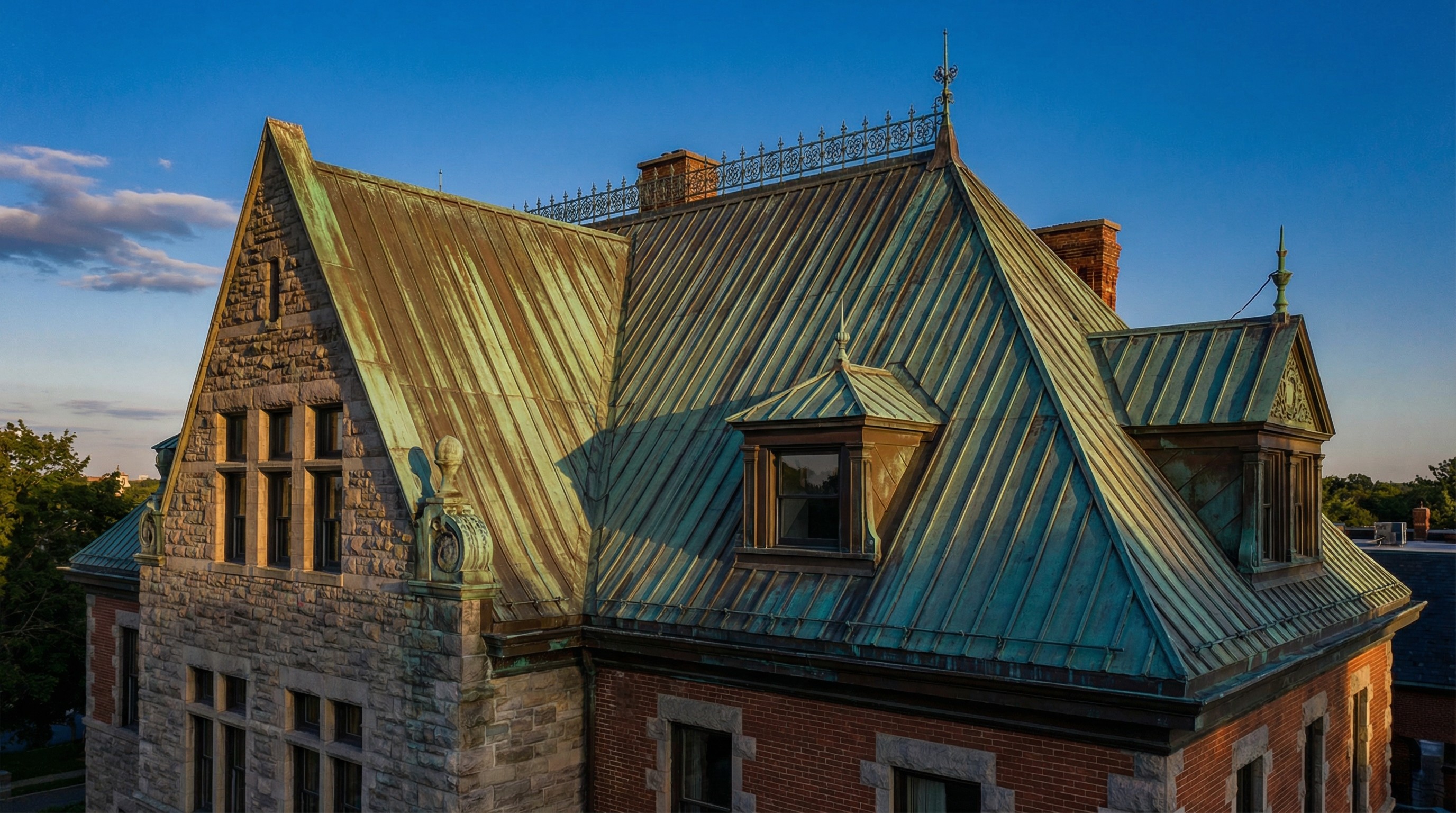
Advantages of copper roofing
Extremely long lifespan: Copper roofs can last well over a century with minimal maintenance, often outlasting the building itself.
Distinctive appearance: The patina that develops over decades creates a look no other material can replicate.
No coatings required: Copper naturally resists corrosion without any protective layers.
Disadvantages of copper roofing
Very high cost: Copper typically costs 3-5 times more than steel, making it one of the most expensive roofing materials available.
Soft metal: Like aluminum, copper dents more easily than steel.
Appearance changes over time: The green patina develops whether you want it or not, so if you prefer the original copper color, you'll need ongoing maintenance to preserve it.
Zinc roofing pros and cons
Zinc is another premium metal with characteristics similar to copper. It's durable, environmentally friendly, and develops a protective patina over time. While less common in residential roofing than steel or aluminum, zinc has some unique properties worth knowing about.
Advantages of zinc roofing
Self-healing surface: Minor scratches in zinc roofing seal themselves as the patina forms, which helps maintain the protective layer.
Long lifespan: Zinc roofs can last as long as copper, often 80 to 100 years or more.
Recyclable: Zinc is highly recyclable and requires less energy to produce than some other metals.
Disadvantages of zinc roofing
Premium pricing: Zinc costs 3-5 times more than steel, similar to copper pricing, which typically limits its use to high-end custom homes or architectural accents.
Limited contractor experience: Fewer roofers have worked with zinc, which can make finding qualified installers more difficult.
Chalking in some climates: Zinc can develop a white residue in certain weather conditions, which affects appearance.
What is tin roofing
Here's an important clarification that many homeowners find helpful: when people say "tin roof," they're almost always talking about steel or aluminum. True tin roofing is rarely used today and hasn't been common for decades.
Historically, tin roofs were steel panels coated with a thin layer of tin to prevent rust. The term stuck around in everyday language even after manufacturers switched to other coatings. In most cases, contractors are referring to galvanized steel, Galvalume, or aluminum when they mention tin roofing.
Styles of metal roofs for residential homes
Now that you know the materials, let's talk about panel styles. The style you choose affects how your roof looks, how it gets installed, and what you'll pay. Different styles also work better with certain home architectures.
Standing seam metal roofing
Standing seam roofs have flat panels with raised vertical seams that run from the ridge down to the eave. The fasteners are hidden beneath the seams rather than exposed on the surface, which creates a clean, modern look and provides excellent water resistance since there are no screw holes for water to penetrate.
Standing seam costs more than other styles, but the concealed fasteners mean less maintenance over time. You won't have screws loosening or rubber washers degrading like you would with exposed fastener systems.
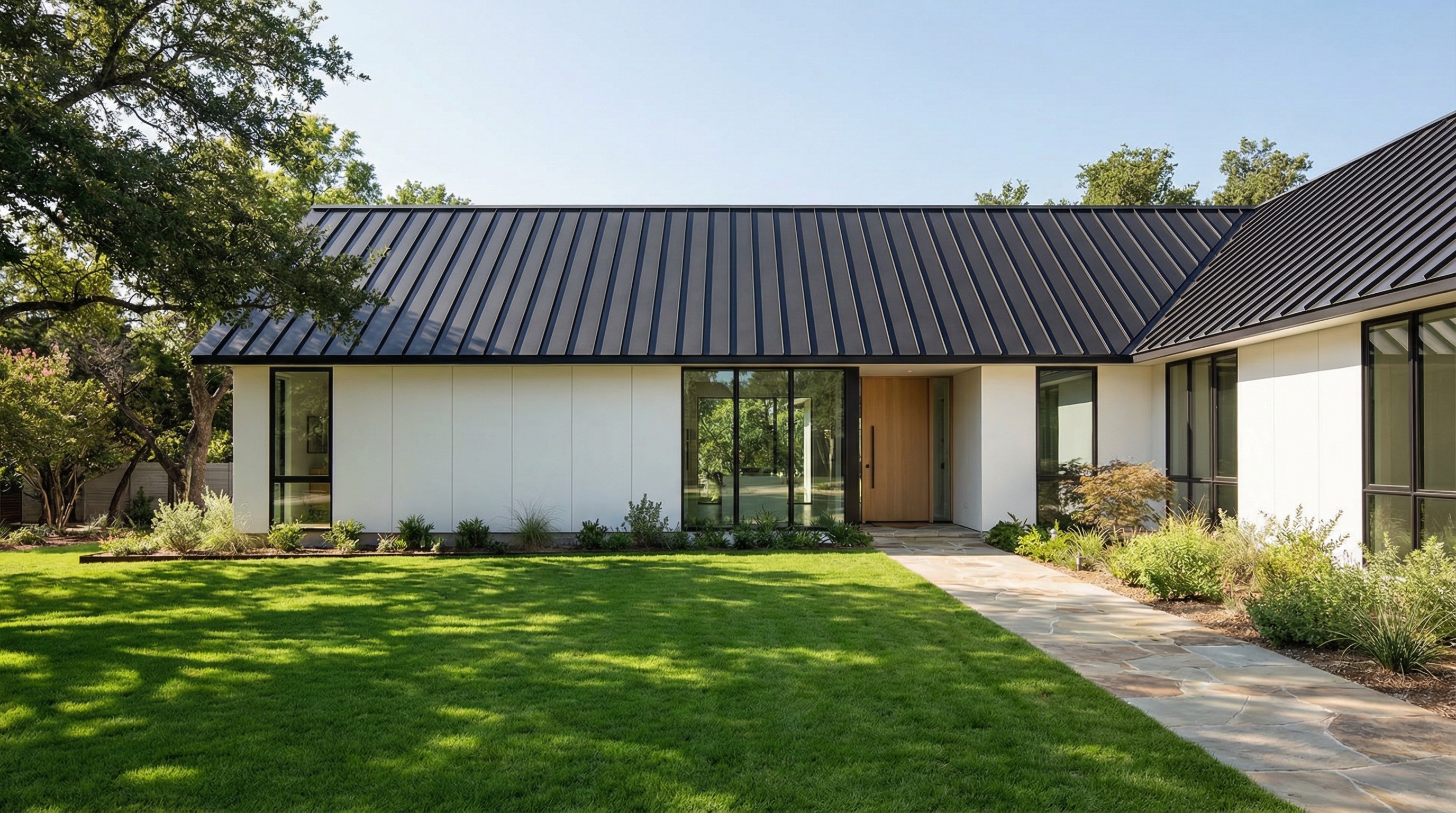
Corrugated metal roofing
Corrugated panels have a wavy or ribbed pattern with fasteners visible on the surface. It's the style most people picture when they think of a barn roof or farmhouse. Corrugated metal is more affordable than standing seam and installs faster, but the exposed screws may need attention after 15-20 years as the rubber washers beneath them age and compress, potentially requiring re-sealing or fastener replacement.
Metal shingle roofing
Metal shingles are individual pieces designed to look like traditional asphalt or wood shingles. From the street, a metal shingle roof can be hard to distinguish from a conventional shingle roof. Homeowners often choose metal shingles when they want the longevity of metal but live in HOA communities or historic districts that require a traditional appearance.
Metal tile and slate roofing
Metal tile and slate panels are stamped to resemble clay tiles or natural slate. They weigh far less than the real thing, which matters for older homes that weren't built to support heavy roofing materials. You'll see metal tile often on Mediterranean or Spanish-style houses where the look of clay tile fits the architecture.
Ribbed metal panels
Ribbed panels, sometimes called R-panels or PBR panels, have a profile similar to corrugated but with a different shape. They're often the most affordable metal roofing option and install quickly. While common on agricultural buildings and commercial structures, some homeowners use ribbed panels for budget-conscious residential projects.
Exposed fastener vs concealed fastener metal roofing
One of the most important decisions in metal roofing is whether to go with exposed or concealed fasteners. This choice affects cost, appearance, and how much maintenance your roof will require over its lifetime.
Feature | Exposed fastener | Concealed fastener |
|---|---|---|
Cost | Lower upfront | Higher upfront |
Appearance | Screws visible on surface | Clean, seamless look |
Maintenance | Fasteners may need attention over time | Less ongoing maintenance |
Water resistance | Good | Excellent |
Common styles | Corrugated, ribbed panels | Standing seam |
Exposed fastener systems use screws that go through the panel surface into the roof deck below. The screws have rubber washers that seal out water, but those washers typically need replacement after 15-20 years, which involves re-sealing fasteners across the entire roof-a maintenance task that concealed fastener systems avoid entirely. Concealed fastener systems hide the screws under the seams, eliminating that maintenance concern and providing better protection against leaks.
Metal roofing cost by material type
Metal roofing prices vary widely based on material, panel style, and your local market. Here's how the materials generally compare to each other.
Material | Relative cost | Best suited for |
|---|---|---|
Galvanized steel | Lowest | Budget-conscious projects in moderate climates |
Galvalume steel | Low to moderate | Humid climates, areas with frequent rain |
Stone-coated steel | Moderate | Traditional neighborhoods, HOA communities |
Aluminum | Moderate to high | Coastal homes, saltwater environments |
Zinc | High | Long-term investment, unique appearance |
Copper | Highest | Historic homes, architectural accents |
Steel remains the most affordable option for most homeowners. Aluminum costs more but makes financial sense in coastal areas where steel would corrode. Copper and zinc typically appear as accents or on high-end custom projects rather than covering entire roofs.
Factors that affect metal roofing prices
When you get quotes for a metal roof, you'll notice prices can vary significantly from one contractor to another. Several factors explain the differences.
Material gauge: Gauge refers to metal thickness, and lower gauge numbers mean thicker metal. A 24-gauge panel costs more than a 29-gauge panel but lasts longer and resists denting better.
Panel style: Standing seam costs more than corrugated or ribbed panels due to the more complex installation.
Roof size and pitch: Larger roofs require more material. Steeper roofs take longer to install and increase labor costs.
Complexity: Dormers, valleys, skylights, and multiple roof levels all add to installation time and cost.
Regional pricing: Material costs fluctuate with the steel market, and labor rates vary by location.
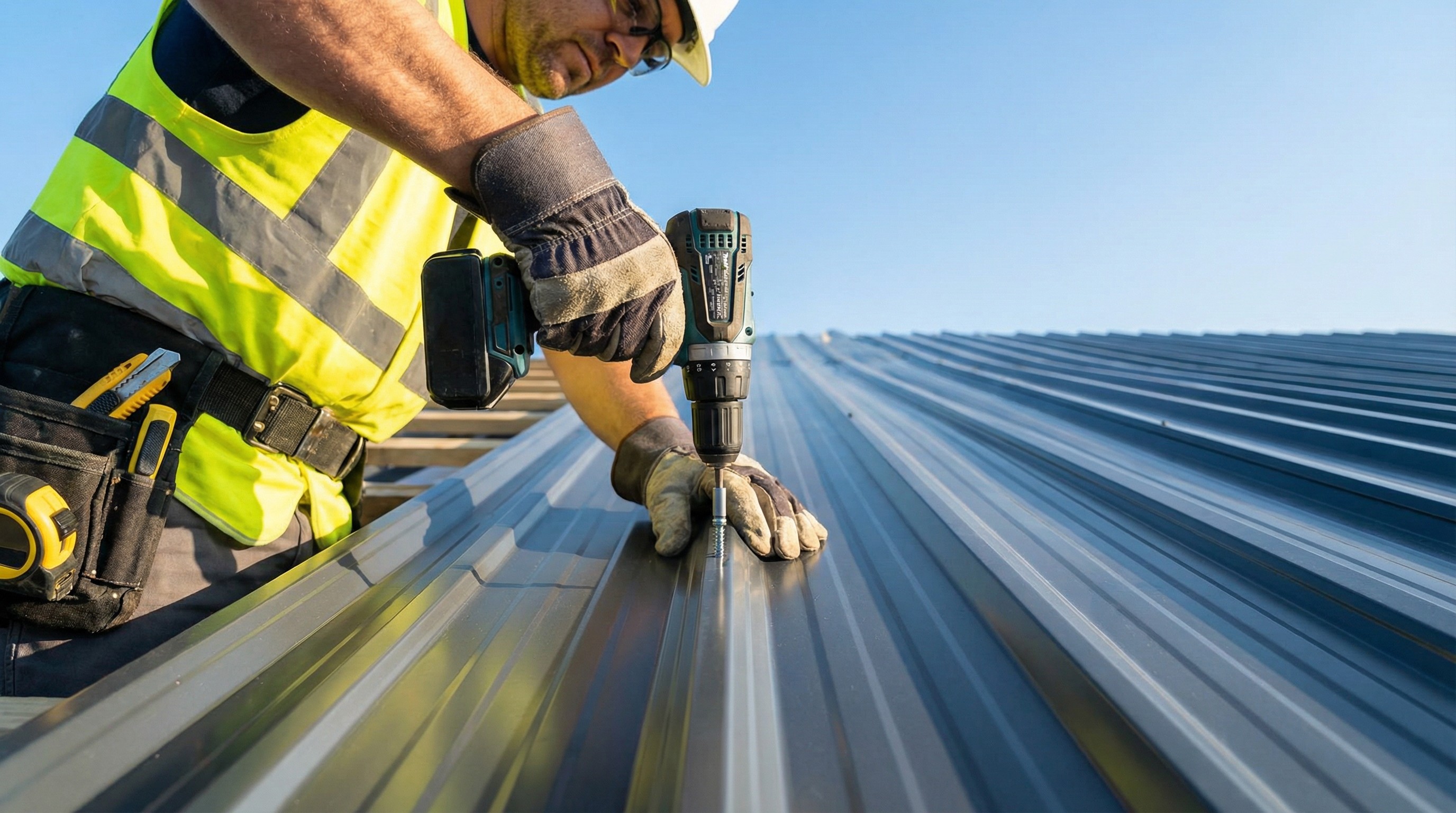
How to choose the right metal roof for your home
Your best choice depends on where you live, what your home looks like, and what you're willing to spend.
Climate: Coastal areas benefit from aluminum's rust resistance. Humid inland regions do well with Galvalume steel.
Home style: Modern and contemporary homes suit standing seam. Traditional homes often look better with metal shingles or stone-coated steel.
Budget: Steel offers the best value for most homeowners. Copper and zinc are long-term investments that make sense for specific situations.
HOA or historic requirements: Check any restrictions before committing to a style. Metal shingles and stone-coated steel often satisfy appearance requirements that would rule out standing seam.
How to compare metal roofing quotes
Getting multiple quotes is the best way to understand fair pricing in your area. But comparing quotes means looking beyond the bottom-line number.
Request line-item breakdowns: A detailed quote shows exactly what you're paying for materials, labor, permits, and disposal separately.
Match specifications: Make sure each quote uses the same material, gauge, and panel style before comparing prices.
Review warranty terms: Material warranties and workmanship warranties vary between manufacturers and contractors.
Verify experience: Metal roofing installation differs from asphalt shingle work. Ask how many metal roofs each contractor has installed.
Quotes for the same roof can vary by 20% or more, which is exactly why homeowners worry about overpaying or being misled. Line-item details help you understand whether a lower price reflects efficiency or cut corners, and whether a higher price includes better materials or just higher margins. This transparency is essential for making a confident decision.




